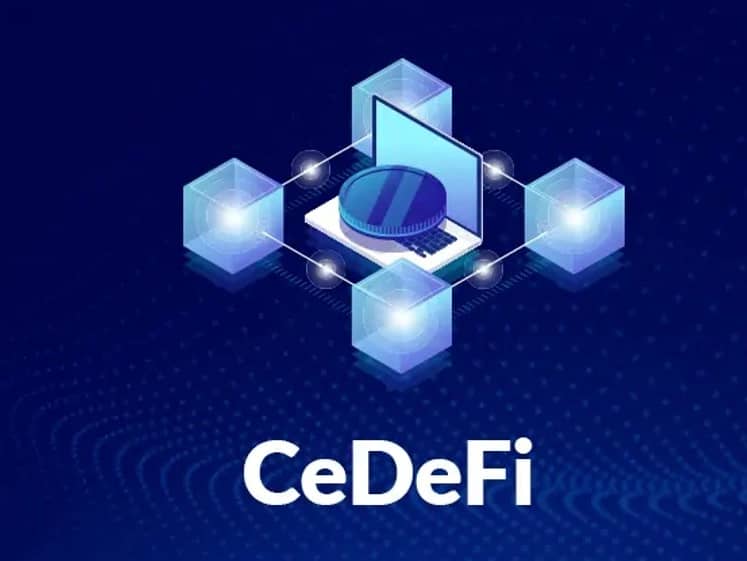위키 구독하기
Share wiki
Bookmark
CeDeFi (Centralized Decentralized Finance)
에이전트 토큰화 플랫폼 (ATP):에이전트 개발 키트(ADK)로 자율 에이전트 구축
CeDeFi (Centralized Decentralized Finance)
**CeDeFi(Centralized Decentralized Finance)**는 중앙화된 금융(CeFi)와 탈중앙화 금융(DeFi)의 결합입니다. CeDeFi는 DeFi 프로토콜과 동일한 기능을 제공하면서 중앙화되어 탈중앙화 거래소(DEX), 유동성 집계기, 수익 농사 도구, 대출 프로토콜과 같은 DeFi 상품에 대한 접근을 허용하는 동시에 CeFi 시스템의 장점을 활용합니다. [1][9]
개요
중앙화된 금융(CeFi)는 확립된 기관, 규정 및 친숙한 사용자 경험을 제공합니다. 반면 탈중앙화 금융(DeFi)는 혁신, 접근성 및 기존 금융 모델을 붕괴시킬 가능성을 추구하며 두 세계의 강점을 결합하여 CeFi와 DeFi의 장점을 활용하는 하이브리드 시스템을 만듭니다.
CeDeFi의 주요 요소는 다음과 같습니다.
- 중앙화: CeDeFi 플랫폼은 일반적으로 은행이나 핀테크 회사와 같은 기존 금융 기관에서 운영합니다. 즉, 플랫폼 관리 및 규정 준수를 담당하는 중앙 당국이 있습니다.
- 탈중앙화: CeDeFi 플랫폼은 종종 블록체인 기술과 스마트 계약을 사용하여 특정 프로세스를 자동화하고 투명성을 제공합니다. 여기에는 온체인 자산 토큰화, 개인 간 대출 및 자동 수익 생성과 같은 기능이 포함될 수 있습니다.
CeDeFi는 중앙화 및 탈중앙화 금융 모델의 하이브리드로 기존 암호화폐 모델을 개선하여 더 빠른 거래, 향상된 보안, 더 큰 거래량 및 상대적으로 낮은 수수료를 허용하는 것을 목표로 합니다. CeDeFi에서는 금융 서비스의 특정 측면이 중앙화되는 반면 다른 측면은 탈중앙화됩니다. 이러한 접근 방식은 중앙화된 금융 시스템의 효율성과 접근성과 블록체인 및 암호화폐 기술의 신뢰성 부족 및 탈중앙화 간의 균형을 맞추는 것을 목표로 합니다. [5][7][6][8]
CeDeFi는 합성 자산의 생성 및 거래를 가능하게 하는 탈중앙화 금융 프로토콜의 한 유형입니다. 대출 또는 차용 플랫폼에 의존하지 않습니다. 대신 기본 자산의 가격을 추적하는 새로운 토큰을 주조하는 스마트 계약 시스템을 사용합니다. 이를 통해 사용자는 중앙화된 당사자를 신뢰할 필요 없이 파생 상품을 거래할 수 있습니다. [2]
CeDeFi의 장점
- DeFi에 대한 접근성 증가: CeDeFi는 특히 완전히 탈중앙화된 플랫폼의 고유한 위험과 복잡성에 대해 우려하는 사람들에게 DeFi 제품 및 서비스에 대한 접근성을 더 넓은 대상에게 제공합니다.
- 향상된 보안 및 안정성: CeDeFi 플랫폼은 기존 금융 기관의 확립된 보안 및 규제 프레임워크의 이점을 누려 DeFi와 관련된 일부 위험을 완화할 수 있습니다.
- 향상된 사용자 경험: CeDeFi 플랫폼은 기존 DeFi 프로토콜에 비해 더 사용자 친화적인 경험을 제공할 수 있으며, 종종 친숙한 인터페이스와 간소화된 온보딩 프로세스를 제공합니다.
- 더 큰 혁신: CeDeFi는 중앙화 및 탈중앙화 플레이어 간의 협업을 촉진하여 새롭고 혁신적인 금융 상품 및 서비스 개발로 이어질 수 있습니다.
CeDeFi의 과제
- 중앙화에 대한 우려: CeDeFi는 이점을 제공하지만 검열 저항 및 완전한 커뮤니티 거버넌스와 같은 DeFi의 주요 장점 중 일부를 잃을 가능성에 대한 우려도 제기합니다.
- 규제 불확실성: CeDeFi를 둘러싼 규제 환경은 여전히 진화하고 있으며, 이는 기업과 사용자에게 불확실성을 야기할 수 있습니다.
- 기술적 복잡성: 중앙화 및 탈중앙화 기술을 통합하는 것은 상당한 전문 지식과 인프라 개발이 필요하기 때문에 어려울 수 있습니다.
CeDeFi 사례
바이낸스 스마트 체인
바이낸스 스마트 체인은 바이낸스 암호화폐 거래소의 기본 블록체인인 바이낸스 체인과 병렬로 실행되는 블록체인 네트워크입니다. 바이낸스 스마트 체인은 스마트 계약 및 DeFi 애플리케이션을 지원하는 동시에 빠른 거래, 낮은 수수료 및 바이낸스 체인 및 이더리움과의 크로스체인 호환성을 제공합니다. [10]
Midas.Investments
Midas.Investments는 고객에게 CeDeFi 전략을 제공하는 보관형 암호화폐 투자 플랫폼입니다. Midas.Investments는 Aave, Compound, MakerDAO와 같은 다양한 대출 프로토콜에서 자산 관리를 처리하기 위해 스마트 계약을 사용합니다. Midas.Investments는 선물 및 옵션과 같은 CeFi의 헤지된 상품에 대한 접근도 제공합니다. [11]
잘못된 내용이 있나요?
